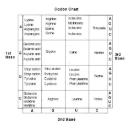Yahoo Answers is shutting down on 4 May 2021 (Eastern Time) and the Yahoo Answers website is now in read-only mode. There will be no changes to other Yahoo properties or services, or your Yahoo account. You can find more information about the Yahoo Answers shutdown and how to download your data on this help page.
What limits a cell’s size?
Please help with this.
Thank You!!
3 Answers
- ATP-ManLv 71 decade agoFavourite answer
Cell Size is governed by several factors: The size of the cell is controlled by metabolic requirements. DNA must be available to produce the enzymes and proteins needed for proper functioning. A too small cell will not have enough DNA to support life and a cell too large will need an enormous amount of DNA to carry on its functions. A second restriction involves surface area to volume ratio. As the cell increases in size, the volume increases geometrically while the surface area increases arithmetically. Eukaryotic cells cope with these problems in that they contain membrane bound organelles. These organelles break up the volume of the cell performing distinct functions which cuts down on the raw materials needed. Each part of the cell does not need the same material to function.
- OKIM IMLv 71 decade ago
The surface area to volume ratio limits the cell's size.
The surface area increases as a function of the square of the radius of the cell, whereas the volume increases as a function of the cube of the radius. The surface area to volume ratio gets smaller as the size of the cell increases. As nutrients and wastes have to pass through the cell membrane, at certain point, the surface area can no longer supply the need of the cell. At that point, the cell stops growing.
- 1 decade ago
the need to maximize surface area. cells absorb things from the environment, and it needs the largest surface area per size to be efficient. and the larger the cell is, the smaller its relative surface area becomes and the less efficient it becomes.


